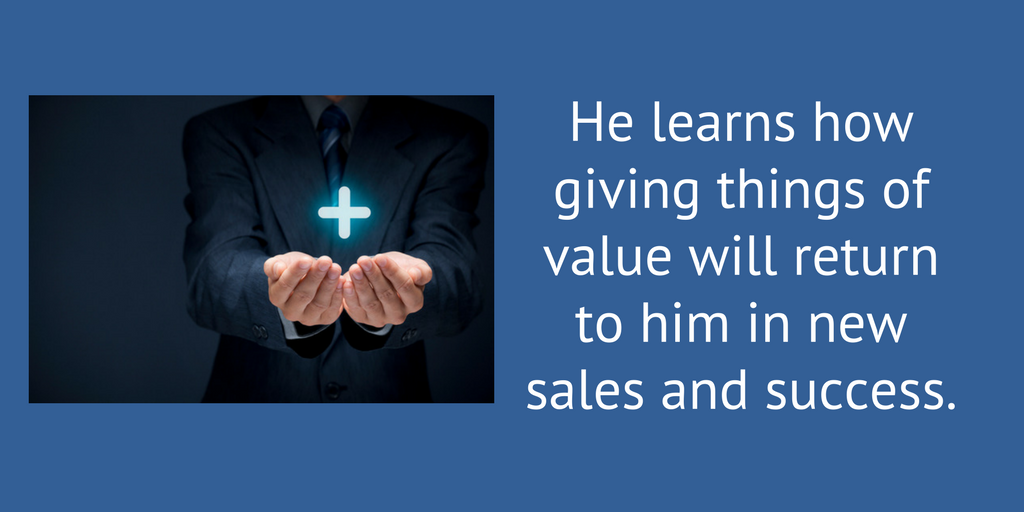When you create content, you’re giving of yourself and your business. The “give and you shall receive” approach aligns with The Go-Giver, a book that not only is a must-read for your marketing and sales team, but also underpins everything content marketing is about.
Content marketing, especially for a small marketing team, requires a heckuva lot of giving. You’re giving away solutions to problems. You’re giving your time to create the content that explains those solutions. And you’re giving away resources to share that content in a variety of ways.
Sometimes we wonder how all this giving can result in positive results for our companies. But if you embrace the giving philosophy brilliantly described in the book The Go-Giver by Bob Burg and John David Mann, you’ll see the results in a very big way.
For this post, we reached out to co-author Bob Burg for some insights into the book. We’ll also show you why — and how — the philosophy can work for you.
The origin of The Go-Giver
The Go-Giver is one of the most influential books I’ve read this year, in both its philosophy and its construction.
The book is written as a parable. It’s the story of a salesman named Joe who is generating less than optimum results through traditional sales methods. He calls on people, he begs for appointments, he keeps clawing for the big deal. But he strikes out, time and time again.
Eventually, Joe encounters a series of people who reveal to him the Five Laws of Stratospheric Success. Slowly, he learns how “giving” things of value — advice, referrals, time — will return to him in new sales and success.
We’ve all read our share of dry business books; this one is brilliantly executed. The story format makes it an enjoyable read, and it’s concise, delivering the point efficiently without sacrificing style points.
Bob Burg gives credit for the storytelling to his co-author, a brilliant writer who has authored many business books. Burg himself had written books including Endless Referrals, which he described as more of a “how-to” book.
The Five Laws of Stratospheric Success applied to content marketing
The two authors collaborated to develop the book’s Five Laws of Stratospheric Success. “I have a background as an entrepreneur and in sales, and John, also an entrepreneur, has been a writer and has interviewed many successful people,” Bob explains. “We found these five laws are things most successful professionals do.”
The laws are an extension of Bob’s book Endless Referrals, in which he demonstrated how you can build relationships with people if they “know you, like you, and trust you.” The crux of that relationship, he said, is that you are giving value all the time.
Value is the critical thread that weaves throughout the five laws. We were fortunate to have Bob reveal how they apply to content marketing.
#1 – The Law of Value
Your true worth is determined by how much more you give in value than you take in payment.
Bob is quick to point out that this law shouldn’t be misunderstood as not making a profit. Price and value are two different things: Value is the relative worth to the end user, whereas price is the dollar value.
In content marketing, you are using your content to get to know people. You’re establishing the relationship where they know, like and trust you. You’re demonstrating your deep knowledge base and your position as a thought leader.
This conveys an important message to your customer. “They believe that by buying from you, they’re going to be better off,” Bob explains. Because of your content, they trust you and your expertise, which is ultimately the reason anyone buys a product or service.
Content builds that level of trust, and it’s of great value to your customer. They willingly pay for your product or service, knowing you’re taking them to a better place.
#2 – The Law of Compensation
Your income is determined by how many people you serve and how well you serve them.
In The Go-Giver, an entrepreneur named Nicole explains that the Law of Value represents your potential income, but the Law of Compensation shows you how much money you can actually make.
You need to reach a wide range of people in order to generate more revenue. Content marketing allows you to reach an incredible amount of people through social media and search engine rankings. However, it only works if you serve them well.
When you do that, it gives you the edge over traditional advertising. While an ad is “pushing” you to buy something, content is serving potential customers well by providing information and value. You’re reaching a bigger audience with valuable content, and you’ll be compensated in return.
#3 – The Law of Influence
Your influence is determined by how abundantly you place other people’s interests first.
Bob notes that top leaders and influencers share the trait of focusing on making other people’s lives better. However, he emphasizes that this should absolutely not be confused with being a “doormat or a martyr.”
A person who has done this extremely well in content marketing is Andy Crestodina, owner of Orbit Media and an expert in content marketing. When I moved to Chicago two years ago (I’ve since returned to Madison, WI), I met Andy at a presentation.
He invited me to one of his Wine & Web events, and has always graciously answered my pestering emails for advice. (I think Andy gets north of 1,000 emails a day, and he tries his darndest to answer them all.)
He never asked me anything in return. The most he ever asked, after much prodding, was for me to encourage people to sign up for his newsletter. It always felt like Andy was putting my interests first, which is why he is so influential in the field.
#4 – The Law of Authenticity
The most valuable gift you have to offer is yourself.
One of the characters in The Go-Giver is named Deborah. She talks about her career in sales, and how despite knowing all the sales skills, people skills, and technical skills, she couldn’t close deals. Finally, she stopped going “by the book” and starting being herself. That’s when her career took off.
“It’s not that skills don’t matter — they absolutely do — it’s just that you need to show up as yourself,” Bob says. “When you do, people will respond.”
We posted about the Law of Authenticity (unknowingly) in this previous post featuring Gini Dietrich, and we will blog about it in an upcoming piece on personal branding featuring Don Stanley.
It’s all about letting yourself show through, and doing it your way. All things being equal, the only thing that sets you apart is, well, YOU. The most effective content marketers blog in a distinctive voice that readers come to know and enjoy.
#5 The Law of Receptivity
The key to effective giving is to stay open to receiving.
“For many people, this is the most difficult law,” Bob says. It’s also the law that ties all five laws together.
The basis of this law is understanding that you’re a giver AND a receiver. Receiving can be as little as accepting a compliment, or as much as accepting payment for your services.
You must allow yourself to receive these things, because they are a reflection of the value you are generating. Receive them, and use them to generate more value.
How The Go-Giver translates into results: Example #1
But does this approach really work? Wouldn’t it be easier to just keep pounding, like Joe was on the phone? I can give you two tangible examples of The Go-Giver in action.
The first happened on July 4th, the day I finished reading the book. This year (2017), July 4th fell on a Tuesday. Because we’d spent the weekend relaxing, my wife and I turned it into a workday, and I used it to finish The Go-Giver.
I was so enthused by its message that I posted a blurb about it on LinkedIn. I wanted nothing more than to tell my network about the book, and the enormous value I believe it holds.
Bob immediately commented on the post, thanking me for the kind words. (Bob was treating it as a workday, too!) I connected with him on LinkedIn, asked him for an interview, and voila — we have this post.
This is a win-win for us. I get to explain The Go-Giver philosophy to my clients and anyone else who’s interested in using Winbound for their content marketing. Bob, in return, gets a nice inbound link to his site, and another firm testimonial for his book.
IMPORTANT: Although this turned into a win-win for Bob and Winbound, Bob makes it clear that you don’t give with an emotional attachment to receiving. You give value to everyone you can because it’s who you are. And, because it’s who you are, it’s what you do.
How The Go-Giver translates into results: Example #2
We produce high-quality content for our clients that takes a lot of time to produce. It includes interviews, graphics, research, back-and-forth edits, outside collaboration. It’s a big workload, but we always want to produce something of value for the reader.
But in the end, Google rewards us with tremendous rankings. We do all the basics with our posts in terms of optimization, but the real benefit is that we are putting tons of valuable content out into the world. Helpful content, that the Google universe is rewarding us for in return.
Here are the number of keywords that are ranking for one of our clients that proves the point.
The best part: You feel great
What I like most about The Go-Giver philosophy is how you feel in the end. It’s simple: You feel good when you do good things for others. That’s a great gift.
It’s amazing how it translates into every facet of your life. You’ll be more energized to help out a special cause. For example, I’ve begun helping the Madison Reading Project, which provides books for needy kids.
Or you just might develop a mindset of helping out someone in need. I was biking downtown the other day, and I stopped and helped a senior citizen and his young grandson lift a dresser into their car. They probably could have done it themselves, but maybe I saved Grandpa a trip to the chiropractor.
I might have done this stuff before The Go-Giver, but Bob and John have shown us how important and beneficial it can be for everyone involved.
Thanks to Bob and John for sharing with us the Five Laws of Stratospheric Success. They’ve shown us how The Go-Giver philosophy truly works in content marketing, sales, and most importantly, life.
Find out how your content and conversion ranks with our interactive version of the Content Scorecard you can fill in yourself – no email required for download.













